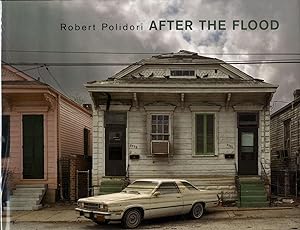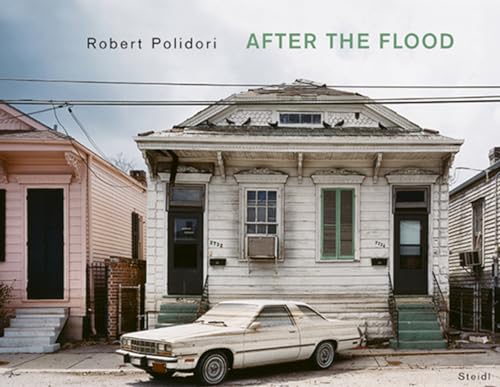Polidori, Robert; Rosenheim, Jeff L (3 results)
Product Type
- All Product Types
- Books (3)
- Magazines & Periodicals
- Comics
- Sheet Music
- Art, Prints & Posters
- Photographs
- Maps
-
Manuscripts &
Paper Collectibles
Condition
- All Conditions
- New
- Used
Binding
- All Bindings
- Hardcover
- Softcover
Collectible Attributes
- First Edition (2)
- Signed (1)
- Dust Jacket (2)
- Seller-Supplied Images (1)
- Not Printed On Demand
Seller Location
Seller Rating
-
Robert Polidori: After the Flood
Published by Steidl, Göttingen, Germany, 2006
ISBN 10: 3865212778ISBN 13: 9783865212771
Seller: Vincent Borrelli, Bookseller, Albuquerque, NM, U.S.A.
Book First Edition
Hardcover. Condition: Fine. Dust Jacket Condition: Fine. 1st Edition. First edition, first printing. Hardcover. Lavender cloth-covered boards with title stamped in green on spine; with photographically illustrated dust jacket. Photographs by Robert Polidori. Introduction by Jeff L. Rosenheim. 336 pp., with four-color plates throughout finely printed in Germany by Steidl. Fine in Fine dust jacket. From the publisher: "In late September 2005, the photographer Robert Polidori travelled to New Orleans to record the destruction caused by Hurricane Katrina. Arriving at night he found few remaining inhabitants amongst the devastated ruins of the city. The next day he began photographing and entering the abandoned houses, many of which were still water-logged or carried the 8 ft tide-mark of the floods. Slowly he began to learn the system of graffiti signs and codes applied to the exterior of the buildings by the rescue forces. Each room he entered seemed to Polidori to be like a womb and he thought of his photographs as the work of a psychological voyeur, mapping the lives of the absent people through their abandoned belongings. The discovery of an abandoned body in one house reinforced his struggle with the problem of making beautiful images from human disaster. As with all his work, Polidori has succeeded in producing much more than a series of documentary images.".
-
Robert Polidori: After the Flood
Published by Steidl, 2006
ISBN 10: 3865212778ISBN 13: 9783865212771
Seller: Griffin Books, Stamford, CT, U.S.A.
Book
Hardcover. Condition: Like New. Polidori signed and dated as new first edition massive hardcover in jacket in original corrugated shipping box. oversized and overweight. Please email for photos. Larger books or sets may require additional shipping charges. Books sent via US Postal.
-
After the Flood
Published by Steidl, E-145, 2006
ISBN 10: 3865212778ISBN 13: 9783865212771
Seller: Last Exit Books, Charlottesville, VA, U.S.A.
Book First Edition Signed
Hardcover. Condition: Very Good. Dust Jacket Condition: Very Good. First Edition; First Printing. Hardcover. Folio. Published by Steidl, Gottingen, Germany. 2006. 336 pgs. Illustrated with color photos. Signed by Robert Polidori on the title page in 2006. First Edition/First printing. DJ has light shelf-wear present to the DJ extremities. Bound in cloth boards with titles present to the spine and front board. Boards have light shelf-wear present to the extremities. No ownership marks present. Text is clean and free of marks. Binding tight and solid. In late September 2005, Robert Polidori traveled to New Orleans to record the destruction caused by Hurricane Katrina and by the city's broken levees. He found the streets deserted, and, without electricity, eerily dark. The next day he began to photograph, house by house: "All the places I went in, the doors were just open. They had been opened by what I collectively call Îthe army,' of maybe 20 National Guards from New Hampshire, 15 policemen from Minneapolis, 20 firefighters from New York. On maybe half of them or a third of them that I went in, I think that the occupants had been there prior. And some of them did leave certain funeral-like mementos before they left. Maybe right after the waters receded they had the chance to just--to go back to their place and just see, and realize there's nothing worth saving." Amidst all this, Polidori has found something worth saving, has created mementos for those who could not return, documenting the paradoxically beautiful wreckage. In classical terms, he has found ruins. The abandoned houses he recorded were still waterlogged as he entered and as he learned (by trial and error, a process that including finding a dead body) the language of signs and codes in which rescue workers had spray-painted each house's siding. He sees the resulting photographs as the work of a psychological witness, mapping the lives of the absent and deceased through what remains of their belongings and their homes. ; Folio 13" - 23" tall; 336 pages; In late September 2005, Robert Polidori traveled to New Orleans to record the destruction caused by Hurricane Katrina and by the city s broken levees. He found the streets deserted, and, without electricity, eerily dark. The next day he began to photograph, house by house: "All the places I went in, the doors were just open. They had been opened by what I collectively call the army, of maybe 20 National Guards from New Hampshire, 15 policemen from Minneapolis, 20 firefighters from New York. On maybe half of them or a third of them that I went in, I think that the occupants had been there prior. And some of them did leave certain funeral-like mementos before they left. Maybe right after the waters receded they had the chance to just--to go back to their place and just see, and realize there s nothing worth saving." Amidst all this, Polidori has found something worth saving, has created mementos for those who could not return, documenting the paradoxically beautiful wreckage. In classical terms, he has found ruins. The abandoned houses he recorded were still waterlogged as he entered and as he learned (by trial and error, a process that including finding a dead body) the language of signs and codes in which rescue workers had spray-painted each house s siding. He sees the resulting photographs as the work of a psychological witness, mapping the lives of the absent and deceased through what remains of their belongings and their homes. ; Signed by Author.



